
Fazul Abdullah Mohammed was a Comorian-Kenyan member of al-Qaeda, and the leader of its presence in East Africa. Mohammed was born in Moroni, Comoros Islands and had Kenyan as well as Comorian citizenship. He spoke French, Swahili, Arabic, English, and Comorian.

Al-Itihaad al-Islami was an Islamist politico-military group in Somalia. Formed in 1983 through a merger of smaller Islamist groups, the organization was the most powerful Islamic movement in the country during the late 80s and early 90s. It also had the most widespread clan following of all the Islamist factions across the nation and professed the aim of creating a Somali Islamic state.
Sheikh Hassan Dahir Aweys (English: Hassan Dahir Aweys (Somali: Xasan Daahir Aweys, is a Somali Islamist political figure. During the regime of Siad Barre, Aweys was a colonel in the Somali National Army and served in the 1977 Ogaden War against Ethiopia.
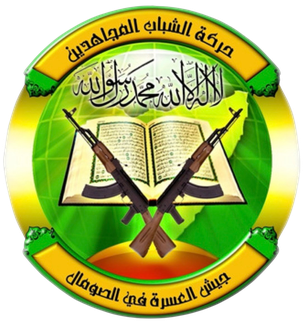
Harakat al-Shabaab al-Mujahideen, commonly known as al-Shabaab, is a Sunni Islamist military and political organization based in Somalia and active elsewhere in East Africa. It is actively involved in the ongoing Somali Civil War and incorporates elements of Somali nationalism into its Islamist cause. Allegiant to the militant pan-Islamist organization al-Qaeda since 2012, it has also been suspected of forging ties with al-Qaeda in the Islamic Maghreb, and al-Qaeda in the Arabian Peninsula.
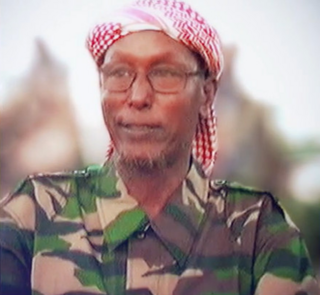
Sheikh Hassan Abdullah Hersi al-Turki was a Somali Islamist who was a senior leader of al-Itihaad al-Islamiya (AIAI) and later founded the Ras Kamboni Brigades.
Aden Hashi Farah Aero was the military commander of the Al Shabaab. He was from the Ayr sub-clan, part of the Habar Gidir, which is a branch of the Hawiye clan. He was reportedly married to Halima Abdi Issa Yusuf. He was among several militants killed in a U.S. airstrike on 1 May 2008.
Kamboni is a town in the Badhaadhe district of Lower Juba region, Somalia, which lies on a peninsula near the border with Kenya. It is the southernmost town in Somalia. The tip of that peninsula is called Ras Kamboni. The town is located 274 kilometers south of Kismayo. The Town population is 79,000. American officials have said that it has served as a training camp for extremists with connections to Al-Qaeda; al-Sharq al-Awsat reported in May 1999 that al-Qaeda was installing sophisticated communications equipment in the camp.

Operation Enduring Freedom – Horn of Africa (OEF-HOA) is a component of Operation Enduring Freedom (OEF). The Combined Joint Task Force – Horn of Africa (CJTF-HOA) is the primary military component assigned to accomplish the objectives of the mission. The naval components are the multinational Combined Task Force 150 (CTF-150) and Combined Task Force 151 (CTF-151) which operates under the direction of the United States Fifth Fleet. Both of these organizations have been historically part of United States Central Command. In February 2007, United States President George W. Bush announced the establishment of the United States Africa Command which took over all of the area of operations of CJTF-HOA in October 2008.

The Somali civil war (2009–present) is the ongoing phase of the Somali civil war which is concentrated in southern and central Somalia. It began in late January 2009 with the present conflict mainly between the forces of the Federal Government of Somalia assisted by African Union peacekeeping troops and al-Shabaab militants who pledged alliegence to al-Qaeda during 2012.
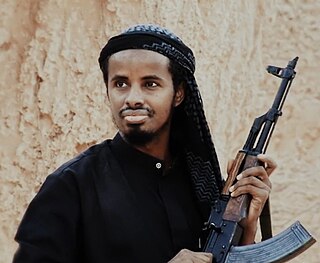
Ahmed Abdi Godane, also known as Mukhtar Abu Zubair, was the Emir (leader) of Al-Shabaab, an Islamist Terrorist group based in Somalia. Godane, who received training and fought in Afghanistan, was designated by the United States as a terrorist. The exact date of Godane's rise to al-Shabaab's Emir is debated, although it seems he ascended to this position in December 2007.

Omar Shafik Hammami, also known by the pseudonym Abu Mansoor al-Amriki, was an American citizen who was a member and leader in the Somali Islamist militant group al-Shabaab. A federal warrant for his arrest was issued in 2007. In November 2012, the FBI added Hammami to its Most Wanted Terrorists list.
The War on Terror is the campaign launched by the United States of America in response to the September 11 attacks against organizations designated with terrorism. The campaign, whose stated objective was eliminating international terrorism, began in 2001. The following is a timeline of events linked to the War on Terror.
Mansour Nasser al Bihani is a citizen of Yemen who is reported to have died fighting in Somalia in 2011. He is reported to have been "killed in a clash with American forces off the coast of Somalia." A martyrdom statement was published on November 26, 2011.
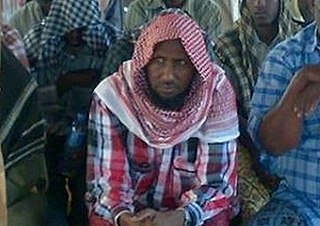
Ahmad Diriye, also known as Ahmad Umar or Abu Ubaidah al-Somali, is the Emir of Somalia’s Islamist group Al-Shabaab. He was listed by the U.S. State Department as a Specially Designated Global Terrorist in April 2015. The Rewards for Justice Program currently offers up to 10 million USD for information regarding him.
This article contains a timeline of events for the Somali jihadist group al-Shabaab.

The Islamic State – Somalia Province or Abnaa ul-Calipha is an Islamic State–affiliated group that primarily operates in the mountainous areas of Puntland, and which has also claimed responsibility for several terrorist attacks throughout the rest of Somalia. Led by Sheikh Abdul Qadir Mumin, the group is estimated to have up to 300 active fighters. Since its formation, ISS probably managed to take control of a small, sparsely populated territory in northern Somalia's mountainous hinterland, though it was not acknowledged as official province ("Wilayat") by IS's central leadership until December 2017. Since then, it has sometimes been called Somalia Province by pro-IS media. ISS is also the declared enemy of al-Shabaab, which considers the Islamic State a significant threat to its own predominance among Jihadist factions in Somalia.
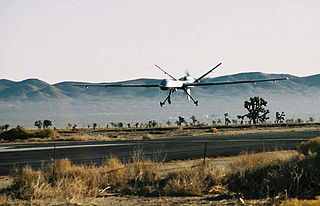
The United States has militarily supported the Transitional Federal Government and the Federal Government of Somalia in conflicts in Somalia since the early 2000's. U.S. military actions in Somalia date back to the 1980s, however following the September 11th attacks, military action was justified as counterterrorism. The Obama administration and the Trump administration conducted drone and fighter aircraft strikes, advisory missions, training, provided intelligence, and attacked al-Shabaab militants. Two U.S. special operations personnel, two contractors, one US Army soldier, and a CIA paramilitary officer have died during operations in Somalia.
This is a 2022 timeline of events in the Somali Civil War (2009–present).
In July 2022, the Islamist militant group al-Shabaab launched an invasion from Somalia into Ethiopia's Somali Region. Following attacks on the Somali side of the border, the rebel militants initially attacked Ethiopia's Afder Zone on 21 July and occupied the town of Hulhul before being driven back by Somali Region paramilitary forces. On 25 July, the militants launched a second incursion at Ferfer which was also defeated. Further cross-border attacks continued in the following days, while Ethiopia launched counter-attacks in response. Clashes between the Somali rebels and security forces inside Ethiopia extended into early August, and at least one small al-Shabaab contingent succeeded in evading the Ethiopian force and reached its main target, the Bale Mountains.

Ali Mohamed Rage, commonly known as Ali Dheere, is the head spokesman for the Somali militant group Al-Shabaab, and a member of the group’s supreme council.











